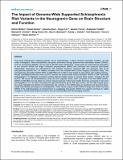The Impact of Genome-Wide Supported Schizophrenia Risk Variants in the Neurogranin Gene on Brain Structure and Function
Author(s)
Walton, Esther; Geisler, Daniel; Hass, Johanna; Liu, Jingyu; Turner, Jessica; Yendiki, Anastasia; Smolka, Michael N.; Ho, Beng-Choon; Manoach, Dara S.; Roessner, Veit; Calhoun, Vince D.; Ehrlich, Stefan; Gollub, Randy Lyanne; ... Show more Show less
DownloadWalton-2013-The Impact of Genome.pdf (479.2Kb)
PUBLISHER_CC
Publisher with Creative Commons License
Creative Commons Attribution
Terms of use
Metadata
Show full item recordAbstract
The neural mechanisms underlying genetic risk for schizophrenia, a highly heritable psychiatric condition, are still under investigation. New schizophrenia risk genes discovered through genome-wide association studies (GWAS), such as neurogranin (NRGN), can be used to identify these mechanisms. In this study we examined the association of two common NRGN risk single nucleotide polymorphisms (SNPs) with functional and structural brain-based intermediate phenotypes for schizophrenia. We obtained structural, functional MRI and genotype data of 92 schizophrenia patients and 114 healthy volunteers from the multisite Mind Clinical Imaging Consortium study. Two schizophrenia-associated NRGN SNPs (rs12807809 and rs12541) were tested for association with working memory-elicited dorsolateral prefrontal cortex (DLPFC) activity and surface-wide cortical thickness. NRGN rs12541 risk allele homozygotes (TT) displayed increased working memory-related activity in several brain regions, including the left DLPFC, left insula, left somatosensory cortex and the cingulate cortex, when compared to non-risk allele carriers. NRGN rs12807809 non-risk allele (C) carriers showed reduced cortical gray matter thickness compared to risk allele homozygotes (TT) in an area comprising the right pericalcarine gyrus, the right cuneus, and the right lingual gyrus. Our study highlights the effects of schizophrenia risk variants in the NRGN gene on functional and structural brain-based intermediate phenotypes for schizophrenia. These results support recent GWAS findings and further implicate NRGN in the pathophysiology of schizophrenia by suggesting that genetic NRGN risk variants contribute to subtle changes in neural functioning and anatomy that can be quantified with neuroimaging methods.
Date issued
2013-10Department
Martinos Imaging Center (McGovern Institute for Brain Research at MIT); Harvard University--MIT Division of Health Sciences and Technology; McGovern Institute for Brain Research at MITJournal
PLoS ONE
Publisher
Public Library of Science
Citation
Walton, Esther, Daniel Geisler, Johanna Hass, Jingyu Liu, Jessica Turner, Anastasia Yendiki, Michael N. Smolka, et al. “The Impact of Genome-Wide Supported Schizophrenia Risk Variants in the Neurogranin Gene on Brain Structure and Function.” Edited by Ryota Hashimoto. PLoS ONE 8, no. 10 (October 2, 2013): e76815.
Version: Final published version
ISSN
1932-6203